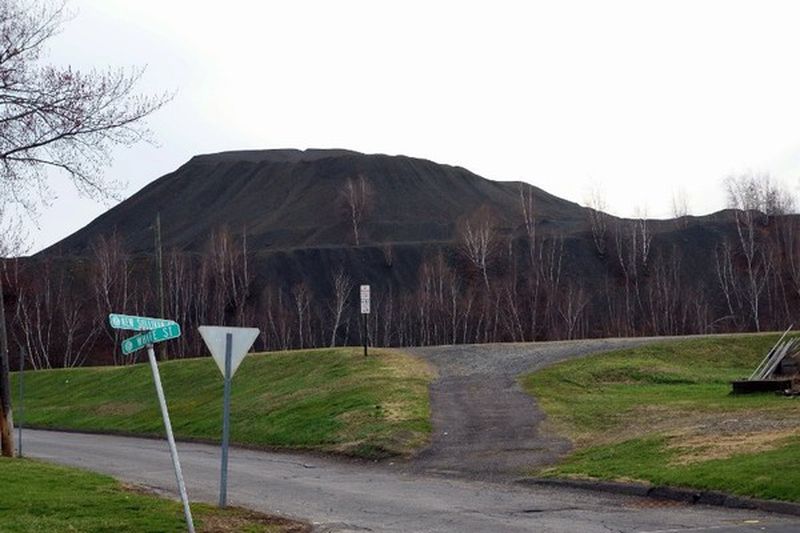For decades, Swoyersville, Pennsylvania, population 5,000, has been split in half by a mountain of nearly half a million tons of coal mining waste. When the wind kicks up, black dust drifts across the town. Teenagers and children ride bicycles and ATVs along the sooty flanks of the 55-acre waste heap, and older locals see it as the unsightly legacy of an industry that once provided jobs and stability but has long since disappeared.
The small mountain that splits Swoyersville is made of culm — a by-product of coal mining — left behind when the Harry E. Colliery operation shut down in the 1970s. And Swoyersville is far from alone: Since the 1700s, when coal mining began in the United States, companies have been digging deep beneath the earth, clear-cutting forests, and blowing the tops off mountains to extract the stuff. When the coal seams ran out, before federal regulations took effect in 1977, operators would often simply abandon their mines, leaving behind piles of waste and contaminated runoff or dangerous open pits and high walls at risk of collapsing. Mine fires have started in culm piles and mine caverns deep underground, in some cases burning for decades on the endless supply of oxygen and fuel, sometimes even forcing the removal of entire townships.

Today, abandoned mine lands exist throughout the U.S.: 5.5 million people live within a mile of one. And in the 40-plus years since the government imposed regulations and taxes to help with cleanup, only a fraction of those abandoned mines have been reclaimed. “We’ve only taken care of about 27% of the AMLs,” says Eric Dixon, a researcher with the Ohio River Valley Institute, a non-profit think tank focused on economic development and clean energy. “And we’re still finding new ones, so the total number keeps growing.” He estimates that more than 850,000 acres of abandoned mine land still need to be reclaimed.
The cost to reclaim these abandoned mines is around $11 billion, according to the Office of Surface Mining Reclamation and Enforcement. But in a recent report, Dixon estimated that the total funding currently needed to clean up and reclaim the abandoned mines throughout the United States is in the neighborhood of $20.9 billion.
The harm caused by abandoned mine lands is concentrated in Appalachia. Some 84% of the damage lies in just seven states: Ohio, Virginia, Kentucky, Tennessee, Alabama, Pennsylvania, and West Virginia. The damage from abandoned mines tends to be located in communities already struggling economically. And the environmental, health, and safety costs of these lands are accompanied by a profound human cost. The move away from coal and other fossil fuels — while both essential and inevitable — has led to decades of job losses, threatening the survival of small townships across the United States. Statistics from the U.S. Energy Information Administration show that close to 50,000 coal mining jobs have disappeared since 2011.
But as the sun sets on America’s coal mining era, new reclamation projects are taking root, transforming scarred lands and contaminated waters into productive resources while creating jobs — both short- and long-term — for the communities around them.
Repurposing resources
In Millfield, Ohio, Sunday Creek has been a bright rust orange for decades, contaminated by acidic iron oxide runoff from a coal mine abandoned in the 1960s. Such acid mine drainage is a widespread consequence of abandoned mines. Rain or groundwater fills the spaces excavated by miners, leaching contaminants into rivers and streams. Aquatic life often can’t survive this contamination, resulting in untold miles of lifeless waterways.
But Sunday Creek will soon run clear again. An innovative social enterprise called True Pigments, owned by the non-profit Rural Action, is deploying a patent-pending technology to remove the iron from the water and transform it into pigments for the paint and construction markets. A pilot system is up and running, and the main treatment plant, which will restore a 7-mile stretch of the creek, will open in 2024. “On day one, when we flip that switch, it will keep all the iron out of the stream and eliminate the acidity,” says Michelle Shively MacIver, who is running the project. “That 7-mile stretch will run clean.”
The market for iron oxide is enormous — its uses include paint, coatings, construction materials, and agriculture. Shively MacIver estimates that True Pigments can capture $1.6 million of that market and provide 8 to 10 long-term jobs with the Sunday Creek site alone, something that could be replicated across coal country. “Every single day, there are 6,000 pounds of iron discharged into Sunday Creek,” she says. “And there are many more sites like this.”
Across state lines, near Hanover Township in Luzerne County, Pennsylvania, a 25-acre strip-mining pit up to 40 feet deep was the legacy of a coal company that departed in the 1960s. During rainstorms, the pit would capture water which would infiltrate into the subsurface mine pools eventually resurfacing as acid mine drainage. In 2002, Earth Conservancy began an ambitious reclamation effort. “It took over 1 million cubic yards of material to fill that hole,” says Terence Ostrowski, PE, who was an engineer on the project. The Earth Conservancy made the land usable, and eventually purchased by NorthPoint Development, which transformed it into a logistics center. Companies like Adidas, Chewy.com, and Patagonia now occupy the site, creating about 2,000 jobs for the region.
The same process is at play on a variety of other sites throughout the state — the scarred and barren land strip-mined by coal companies in the 1940s, ’50s, and ’60s is slowly being cleaned up and put to a variety of uses, such as office parks, distribution centers, housing, and recreation. Ostrowski, now the President/CEO of Earth Conservancy, estimates that since 2014, the organization’s reclamation projects have brought roughly 600 acres of abandoned mine land back to productive use and created around 3,700 jobs.
Clean energy
In Virginia, a grant-funded partnership is reclaiming abandoned mine lands for another purpose: clean energy. A 13-acre former mine in Wise County, Virginia, will soon transform into a solar installation that will supply up to 3 megawatts of clean energy to a data center located next door. It will be the first solar installation on abandoned mine land in the state. The developers, Sun Tribe Solar, plan to break ground in 2022. Sun Tribe’s vice president of development, Rich Allevi, estimates that the project will supply roughly 20% of the data center’s power and inject $1.2 million into the local economy while providing proof of concept for future solar installations. Sun Tribe has several similar solar reclamation projects under development. “The solar potential for abandoned mine lands is really high, in my opinion,” Allevi says.
Plans for solar sites on other abandoned mine sites are in the works. The Nature Conservancy recently purchased a vast, 253,000-acre landholding in Appalachia, encompassing roughly 13,000 acres of abandoned mine sites. A number of them are slated for future solar installations.
And the current administration is ready to invest in reclaiming abandoned mining lands. The recently passed infrastructure bill contains $11.3 billion earmarked for abandoned mines. “That money will be a game-changer,” says Dana Kuhnline, who works on mine reclamation campaigns with Appalachian Voices, an environmental and economic development non-profit. “And this funding is so urgent because these issues are only going to get more expensive to reclaim and more dangerous.”
Her colleague at Appalachian Voices, Adam Wells, directs economic and community development for the region, and he highlights the need for local engagement along the way. “The best ideas come from the community,” Wells says, “and we really need support on the ground for community-driven solutions.”
Back in Swoyersville, PA, a public/private partnership is chipping away at the monolithic pile, hauling the culm to a co-generation waste to energy facility that uses it to generate electricity. Bobby Hughes heads the Eastern Pennsylvania Coalition for Abandoned Mine Reclamation and is helping facilitate the cleanup, which he hopes will be completed within the next 10 years. “This is the kind of reclamation project we hope to see more of down the road,” he says. “But, we need federal dollars to help leverage private sector and state dollars.”

And that help can’t come soon enough. The impacts of the abandoned mines that Swoyersville and other communities live with have lingered for generations. “I’ve lived here all my life,” Hughes says. “Some of those streams I grew up with are still orange from the runoff of these abandoned mines, and my kids and grandkids are now seeing those same orange streams because we haven’t been able to come up with an economics solution and meaningful prioritization for the discharges because of the volumes and chemistry of the mine pool water that remains to be addressed. This issue has been taking a back seat for far too long.”
The Just Transition Fund is on a mission to create economic opportunity for the frontline communities and workers hardest hit by the transition away from coal. JTF is guided by a belief in the power of communities, supporting locally-led solutions and helping elevate the voices of transition leaders.





